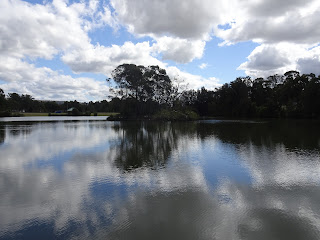Glenmore Loch
The best part about moving into a new area is exploring your new surroundings. Now is the perfect time to do this as we are in Covid Lockdown and not permitted to leave our local Government area. Everyone has been encouraged to participate in exercise walks in their local area so Ken and I are making the most of this opportunity to explore our new environment.
Last Thursday we drove to Glenmore Park and discovered Glenmore Loch. The Loch is set in a park with a walking track all the way around it. It is a beautiful tranquil area and a haven for the local birdlife. There are two bridges over the Loch and outdoor gym fitness equipment dotted alongside the pathway at regular intervals.
We parked our car outside the local Community Centre on the shores of the Loch and walked down to the path and a viewing platform on the shoreline over the Loch. In the centre of the Loch there is an island with many water birds in residence both on the ground and in the trees.
Here is Ken standing on the viewing platform stretching out over the Loch. In the background is the Community Centre and the walking track.The first bridge we came to on our walk spans a culvert for water overflow from the Loch. I love that it is called a Loch and not a Lake. Scottish Lochs seem to put the word Loch first, eg Loch Ness, Loch Lomond but Glenmore Loch is distinctly Australian with the word Loch appearing last!
Big, sturdy outdoor gym fitness equipment is placed alongside the path at regular intervals. Use of this equipment is prohibited during lockdown.
Here is the Loch. The day was overcast and cloudy, as you can see by the many clouds reflected in the water. It would look better on a brighter day. Towards the end of our walk the sun did come out, so I should have gone back and taken more photos! Next time!!
Here is the second bridge, a little bit longer than the first bridge. I like the stone pillars and the wrought iron panels. This bridge is at the end of the Loch and once again spans a culvert.
An Ibis flapping his wings by the edge of the Loch. There were lots of waterbirds, including Purple swamphens, White-faced Herons, Dusky Moorhens as well as many ducks.
There were fish in the Loch and fishing was permitted, subject to size limits. I noticed a sign stating there were Australian Bass, Estuary Perch, Southern Shortfin Eel and Spiny Crayfish in the Loch. We certainly saw evidence of fish as we watched them swimming from the viewing platform.
We completed our circumnavigation of the Loch and returned to our car in the car park.
As we drove out of the area we admired the many lovely homes surrounding the Loch. The area of Glenmore Park was mainly rural prior to the 1970's when the first residential subdivision occurred. In 1990 Glenmore Park was officially opened by the NSW Premier. Its development has been carefully planned to cater for the social, economic and residential needs of its residents. It appears to be a pleasant place to live.
Prior to European settlement, the area was home to the Mulgoa people who spoke the Darug language. The area marked the boundary between two important clans, the Darugs from the plains and the Gundungurra from the Mountains who spoke a different language. In early Colonial days there were many bloody encounters between the Europeans and Aboriginals, However, these clashes were mainly between the Gundungurras and the Europeans. The Mulgoa people remained peaceful.
We shall come back to this beautiful area in future weeks as there is much more to explore.
Acknowledgements
1. Penrith City local history.
2. Wikipedia.















































